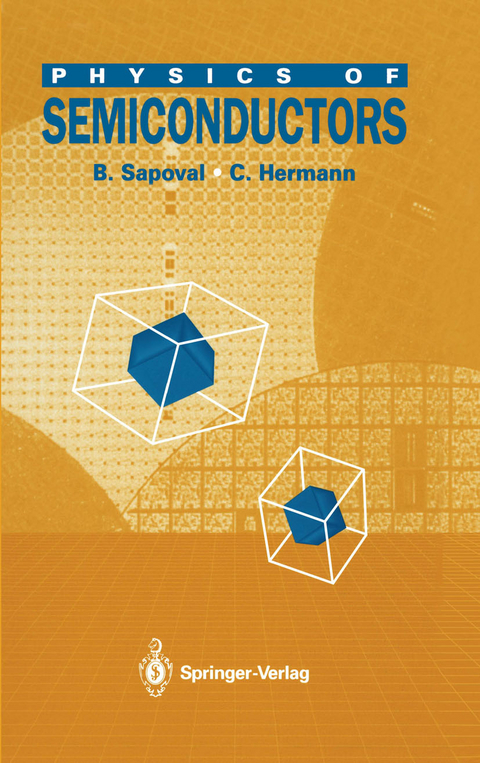
Physics of Semiconductors
Springer-Verlag New York Inc.
978-0-387-40630-5 (ISBN)
1 Simple Ideas about Semiconductors.- 1.1 Definition and Importance of Semiconductors.- 1.2 A Chemical Approach to Semiconductors.- 1.3 Quantum States of a Perfect One-Dimensional Crystalline Solid.- 2 Quantum States of a Perfect Semiconductor.- 2.1 Quantum States of a Three-Dimensional Crystal.- 2.2 Dynamics of a Bloch Electron. The Crystal Momentum.- 2.3 Metal, Insulator, Semiconductor.- 2.4 Theoretical Determination of Band Structure.- 2.5 The True Band Structure.- 2.6 Experimental Study of Band Structure.- Appendix 2.1 Matrix Element of a Periodic Operator between Two Bloch States.- Appendix 2.2 Symmetries of the Band Structure.- Appendix 2.3 Band Structure of Column IV Elements Calculated by the LCAO Method.- Appendix 2.4 The k • p Method.- 3 Excited States of a Pure Semiconductor and Quantum States of Impure Semiconductors.- 3.1 The Hole Concept.- 3.2 Impurities in Semiconductors.- 3.3 Impurity Bands.- Appendix 3.1 Problems on Cyclotron Resonance in Silicon.- Appendix 3.2 QuantumWells and Semiconducting Superlattices.- Appendix 3.3 Amorphous Semiconductors.- 4 Statistics of Homogeneous Semiconductors.- 4.1 Occupation of the Electron Levels.- 4.2 Hole Occupation.- 4.3 Determination of the Chemical Potential.- 4.4 Statistics of Pure or Intrinsic Semiconductors.- 4.5 Statistics of a Semiconductor Containing Impurities: The Notion of Majority and Minority Carriers.- 4.6 Compensated Semiconductor at Intermediate Temperature.- 4.7 Semiconductor at Low Temperatures.- 4.8 Application: The Semiconducting Thermometer.- 4.9 Growth of Pure Crystals.- Appendix 4.1 Occupation Number of a Donor Level.- Appendix 4.2 Problem: Substrates for Microelectronics.- 5 Transport Phenomena in Semiconductors.- 5.1 Introduction.- 5.2 Drude’s Model of Conductivity and Diffusion.- 5.3 Semiclassical Treatment of Transport Processes.- 5.4 The Mobility of Semiconductors.- Appendix 5.1 Problems on the Hall Effect and Magnetoresistance of Semiconductors in the Drude Model.- 6 Effects of Light.- 6.1 Light Absorption by Semiconductors.- 6.2 Recombination.- 6.3 Photoconductivity and its Applications.- Appendix 6.1 Quantum System Submitted to a Sinusoidally Varying Perturbation.- Appendix 6.2 Calculation of the Radiative Recombination Probability.- Appendix 6.3 Semiconducting Clusters for Non-Linear Optics.- 7 Carrier Injection by Light.- 7.1 Basic Equations for Semiconductor Devices.- 7.2 Charge Neutrality.- 7.3 Injection or Extraction of Minority Carriers.- Appendix 7.1 Charge Quasi-Neutrality.- Appendix 7.2 Problems on Photoexcitation, Recombination, and Photoconductivity.- 8 The p—n Junction.- 8.1 Introduction: Inhomogeneous Semiconductors.- 8.2 The Equilibrium p—n Junction.- 8.3 The Non-Equilibrium Junction.- Appendix 8.1 Problem: Non-Stationary p—n Junctions and their High-Frequency Applications.- 9 Applications of the p—n Junction and Asymmetrical Devices.- 9.1 Applications of p—n Junctions.- 9.2 The Metal-Semiconductor Contact in Equilibrium.- 9.3 Non-Equilibrium Metal-Semiconductor Junction.- 9.4 The Semiconductor Surface.- 9.5 Photoemission from Semiconductors.- 9.6 Heterojunctions.- 10 The Principles of Some Electronic Devices.- 10.1 The Junction Transistor.- 10.2 The Field-Effect Transistor.- 10.3 An Application of the MOSFET: The Charge-Coupled Device (CCD).- 10.4 Concepts of Integration and Planar Technology.- 10.5 Band Gap Engineering.- 10.6 Physical Limits in Digital Electronics.- Appendix 10.1 Problems on the n—p—n Transistor.- Appendix 10.2 Problems on the Junction Field-Effect Transistor.- Appendix 10.3 Problems on MOS (Metal-Oxide-Semiconductor) Structure.- Values of the Important Physical Constants.- Some Physical Properties of Semiconductors.
| Übersetzer | A.R. King |
|---|---|
| Zusatzinfo | X, 320 p. |
| Verlagsort | New York, NY |
| Sprache | englisch |
| Maße | 155 x 235 mm |
| Themenwelt | Naturwissenschaften ► Physik / Astronomie ► Atom- / Kern- / Molekularphysik |
| Naturwissenschaften ► Physik / Astronomie ► Elektrodynamik | |
| Naturwissenschaften ► Physik / Astronomie ► Festkörperphysik | |
| Naturwissenschaften ► Physik / Astronomie ► Thermodynamik | |
| ISBN-10 | 0-387-40630-1 / 0387406301 |
| ISBN-13 | 978-0-387-40630-5 / 9780387406305 |
| Zustand | Neuware |
| Informationen gemäß Produktsicherheitsverordnung (GPSR) | |
| Haben Sie eine Frage zum Produkt? |
aus dem Bereich


